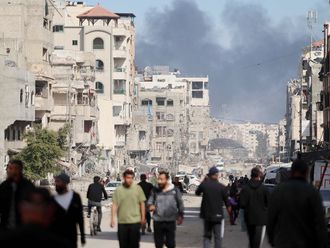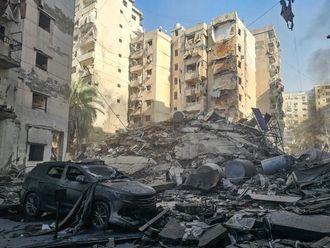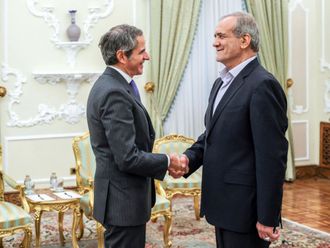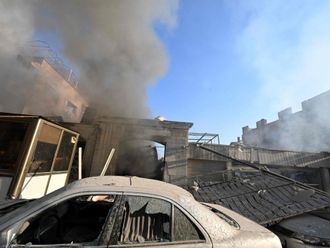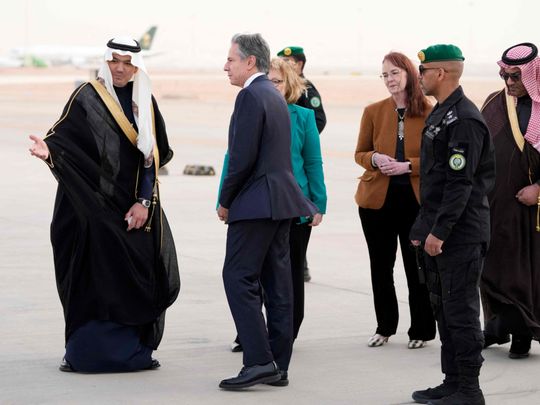
DOHA/RIYADH: Palestinians huddling under bombardment in Gaza said on Monday they hoped a visit to the region by the US secretary of state would finally deliver a truce, in time to head off a threatened new Israeli assault on the last refuge at the enclave’s edge.
Antony Blinken arrived in Riyadh at the start of his first Middle East trip since Washington brokered an offer, with Israeli input, for the first extended ceasefire of the war.
Blinken met with Crown Prince Mohammed bin Salman, and his Saudi counterpart, foreign minister Prince Faisal bin Farhan Al Saud, a US official said.
The veteran diplomat’s latest trip comes at a time senior US officials describe as one of the most dangerous the region has seen in decades. The conflict has escalated as Iran-backed groups have entered the fray and fired on US forces in Iraq and Syria, while Yemen’s Houthis have attacked shipping routes in the Red Sea.
The offer, delivered to Hamas last week by Qatari and Egyptian mediators, still awaits a reply from militants who say they want more guarantees it will bring an end to the four-month-old war in the Gaza Strip.
“Impossible to say if we’ll get a breakthrough, when we’ll get a breakthrough,” a senior US official told reporters during the flight to the Saudi capital.
“The ball right now is in Hamas’ court.”
Beyond the truce itself, Blinken aims to win backing for US plans for what would follow: rebuilding and running Gaza, and ultimately for a Palestinian state — which Israel now rejects — and for Arab countries to normalise ties with Israel.
“If we get a humanitarian pause, we want to be in a position to move as quickly as possible on the various pieces of ‘day after,’” the US official said.
Washington also seeks to prevent further escalation elsewhere in the Middle East, after days of US air strikes against pro-Iranian armed groups across the region.
40-day truce?
Meanwhile, Israel has pressed on with its offensive in some of the war’s most intense combat, and threatened a new ground assault on Rafah, a small city where more than half of Gaza’s 2.3 million people are now penned against the enclave’s southern border abutting Egypt.
The ceasefire proposal, described by sources close to the talks, would see a truce of at least 40 days when militants would free civilians among remaining hostages they are holding, followed by later phases to hand over soldiers and dead bodies.
The only previous truce lasted just one week.
“We want the war to end and we want to go back home, this is all that we want at this stage,” said Yamen Hamad, 35, a father of four reached by messaging app at a U.N. school in Deir al-Balah in central Gaza. The area is one of the few where Israeli tanks have yet to advance and is now jammed with tens of thousands of displaced families.
“All we do is listen to the news through small radios and view the internet looking for hope. We hope that Blinken will tell (Israeli Prime Minister Benjamin) Netanyahu enough is enough, and we hope our factions decide in the best interest of our people.”
Fighting in Khan Younis
In one of the biggest battles of the war, Israeli tanks have been advancing for the past two weeks in Khan Younis, the main southern city, which was already housing hundreds of thousands of people who fled other areas. Fighting has also resurged in Gaza City in the north of the Strip, in areas Israel claimed to have subdued in the first two months of the war.
The Israeli military said on Monday its forces had killed dozens of Palestinian fighters in combat in areas in northern, central and southern Gaza over the last 24 hours.
Palestinians described heavy fighting in Gaza City, particularly its western areas close to the Mediterranean shore, which had come under bombardment from Israeli warships. UNRWRA, the U.N. aid agency for Palestinians, said a food convoy headed there had come under fire, though nobody was hurt.
In Khan Younis, Palestinian health officials said they had recovered the bodies of 14 people killed in a strike overnight.
They have said repeatedly in recent days that rescuers are unable to reach many of the dead and wounded in the city.
Gaza authorities say more than 27,000 Palestinians have been confirmed killed in Israel’s assault, with thousands more dead feared unrecovered in the rubble. Israel says it has lost 226 soldiers in Gaza since 1,200 people were killed and 253 hostages captured in the October 7 Hamas attacks that precipitated the war.
After Israel announced last week that it was preparing for a potential ground assault on Rafah, international aid agencies and the UN said they feared the humanitarian consequences would be catastrophic. Gazans fear it would drive them out of the enclave once and for all into Egypt.
An Israeli official told Reuters that the military would coordinate with Egypt, and seek ways of evacuating most of the displaced people northward elsewhere into Gaza, ahead of any Rafah ground sweep.
A ceasefire now could head off such an assault, but would mean Israel pausing without having achieved its stated aim of annihilating Hamas. Some far-right members of Netanyahu’s cabinet have said they would quit rather than back such a deal.
Netanyahu says he is committed to “total victory”, and that any pause in fighting would only be temporary as long as Hamas fighters are still at large. Hamas says it will not agree a truce or free its hostages unless it receives guarantees that Israel will pull out of Gaza and end the war.
The exiled leader of Hamas, Ismail Haniyeh, said last week he would travel to Cairo to deliver his response to the ceasefire proposal, but he has yet to turn up there and Hamas has set no timetable for his trip.
A Palestinian official with knowledge of the negotiations told Reuters the Hamas response could come “soon”, but it was up to Blinken to nudge Netanyahu to make concessions.


